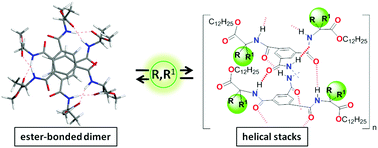Tuning the nature and stability of self-assemblies formed by ester benzene 1,3,5-tricarboxamides: the crucial role played by the substituents†
Abstract
As the benzene 1,3,5-tricarboxamide (BTA) moiety is commonly used as the central assembling unit for the construction of functionalized supramolecular architectures, strategies to tailor the nature and stability of BTA assemblies are needed. The assembly properties of a library of structurally simple BTAs derived from amino dodecyl esters (ester BTAs, 13 members) have been studied, either in the bulk or in cyclohexane solutions, by means of a series of analytical methods (NMR, DSC, POM, FT-IR, UV-Vis, CD, ITC, high-sensitivity DSC, SANS). Two types of hydrogen-bonded species have been identified and characterized: the expected amide-bonded helical rods (or stacks) that are structurally similar to those formed by BTAs with simple alkyl side chains (alkyl BTAs), and ester-bonded dimers in which the BTAs are connected by means of hydrogen bonds linking the amide N–H and the ester C![[double bond, length as m-dash]](https://www.rsc.org/images/entities/char_e001.gif) O. MM/MD calculations coupled with simulations of CD spectra allow for the precise determination of the molecular arrangement and of the hydrogen bond pattern of these dimers. Our study points out the crucial influence of the substituent attached on the amino-ester α-carbon on the relative stability of the rod-like versus dimeric assemblies. By varying this substituent, one can precisely tune the nature of the dominant hydrogen-bonded species (stacks or dimers) in the neat compounds and in cyclohexane over a wide range of temperatures and concentrations. In the neat BTAs, stacks are stable up to 213 °C and dimers above 180 °C whilst in cyclohexane stacks form at c* > 3 × 10−5 M at 20 °C and dimers are stable up to 80 °C at 7 × 10−6 M. Ester BTAs that assemble into stacks form a liquid-crystalline phase and yield gels or viscous solutions in cyclohexane, demonstrating the importance of controlling the structure of these assemblies. Our systematic study of these structurally similar ester BTAs also allows for a better understanding of how a single atom or moiety can impact the nature and stability of BTA aggregates, which is of importance for the future development of functionalized BTA supramolecular polymers.
O. MM/MD calculations coupled with simulations of CD spectra allow for the precise determination of the molecular arrangement and of the hydrogen bond pattern of these dimers. Our study points out the crucial influence of the substituent attached on the amino-ester α-carbon on the relative stability of the rod-like versus dimeric assemblies. By varying this substituent, one can precisely tune the nature of the dominant hydrogen-bonded species (stacks or dimers) in the neat compounds and in cyclohexane over a wide range of temperatures and concentrations. In the neat BTAs, stacks are stable up to 213 °C and dimers above 180 °C whilst in cyclohexane stacks form at c* > 3 × 10−5 M at 20 °C and dimers are stable up to 80 °C at 7 × 10−6 M. Ester BTAs that assemble into stacks form a liquid-crystalline phase and yield gels or viscous solutions in cyclohexane, demonstrating the importance of controlling the structure of these assemblies. Our systematic study of these structurally similar ester BTAs also allows for a better understanding of how a single atom or moiety can impact the nature and stability of BTA aggregates, which is of importance for the future development of functionalized BTA supramolecular polymers.



 Please wait while we load your content...
Please wait while we load your content...